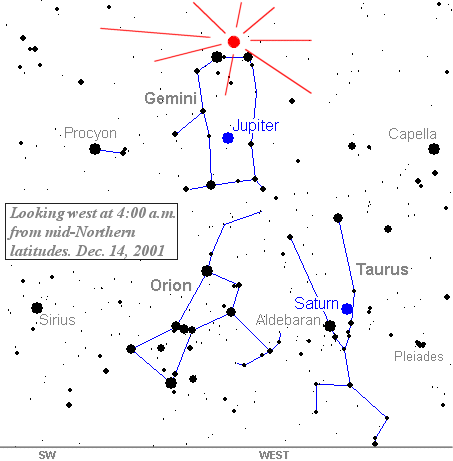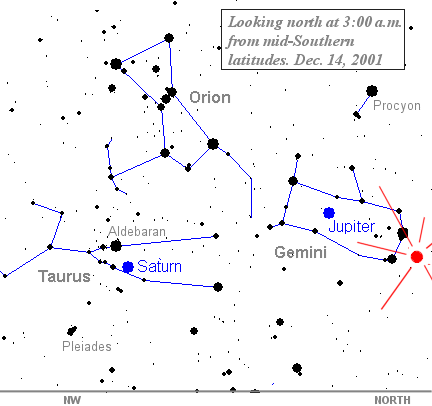|
Dec. 13-14, 2001 back to spaceweather.com The 2001 Leonid meteor storm whetted the appetites of sky watchers for more meteors. Fortunately the Geminids will soon be here. Peaking in mid-December, the Geminids produce as many as 100 shooting stars per hour. That's about 10 times less intense than the recent Leonid peak, but nevertheless a nice display. Quick Facts:
Geminid meteors fly out of a point in the sky (called "the radiant") near the star Castor in the constellation Gemini. Fortunately for novices it isn't necessary to find Gemini to enjoy the show. During the shower, meteors can appear anywhere in the sky -- although their trails will point back to the radiant. To see them simply go outside (don't forget to dress warmly if you live in the wintry northern hemisphere) and look up; the unaided eye is the best tool for watching meteors. Observers in the northern hemisphere will have the best view of the shower because Gemini climbs so high in northern skies. As seen from mid-Northern latitudes, Gemini rises just after sunset and soars overhead around midnight. The hour after sunset on Dec. 13th will be a good time for sky watchers in Europe, North America, northern Africa, and western Asia to spot a few Geminid Earthgrazers. Later, during the hours between midnight and dawn on Dec. 14th, the meteor rate will climb to 100 or more per hour. East Asians will see the greatest number of Geminids during the hours before dawn on Friday, Dec. 14th, and perhaps a smattering of Earthgrazers after sunset on the same day.  Above: As viewed from mid-northern latitudes, Gemini will appear high in the western sky at 4 o'clock in the morning on Dec. 14th. This is true for all time zones. The Geminid radiant is denoted by a red dot. Southern-hemisphere observers won't see as many Geminids because the constellation never rises much higher than 30 degrees above their horizon. Nevertheless, the shower will produce dozens of bright shooting stars and so it's worth watching. Sky watchers in southern Africa and South America might see a few Earthgrazing Geminids around 10 p.m. local time on Dec. 13th, and a larger number of "ordinary" Geminids between local midnight and dawn on Dec. 14th. Sky watchers in Australia, New Zealand, and surrounding areas near the international date line will see the greatest number of Geminids during the hours between 1 a.m. and dawn on Friday, Dec. 14th, and perhaps some Earthgrazers after sunset later that same day.  Above: The northern sky as viewed from South Africa on the date of the 2001 Geminid meteor shower. The Geminid radiant, about 30 degrees above the horizon, is denoted by a red dot. And finally, Earthgrazers: They are disintegrating meteoroids that fly over the horizon nearly parallel to the atmosphere. Earthgrazers are slow-moving and produce long colorful tails. Observers in North America, Europe and western Asia are favored for Geminid Earthgrazers just after local sunset on Dec. 13th. Clear skies and good meteor hunting! |
